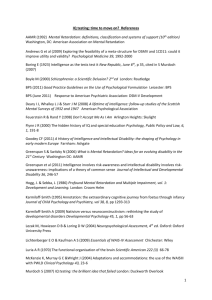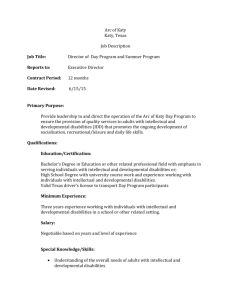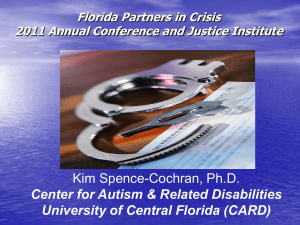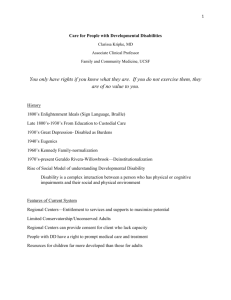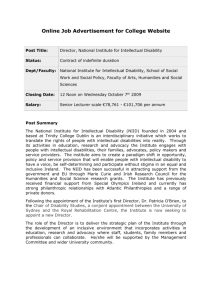Introduction to Intellectual Disabilities
advertisement
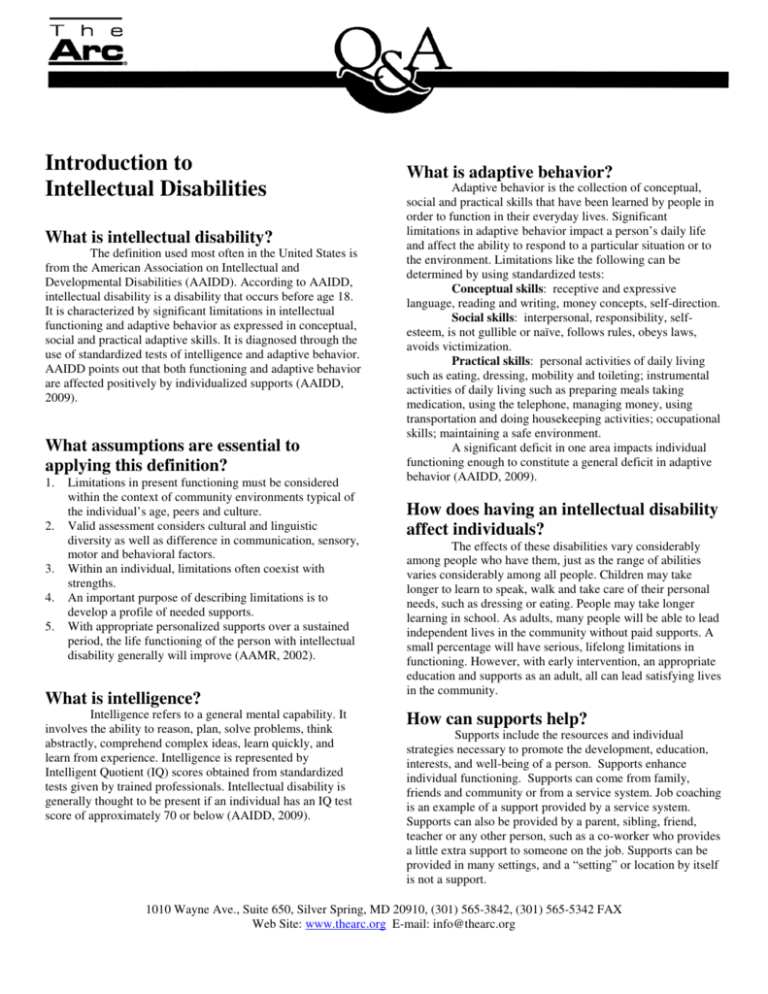
Introduction to Intellectual Disabilities What is intellectual disability? The definition used most often in the United States is from the American Association on Intellectual and Developmental Disabilities (AAIDD). According to AAIDD, intellectual disability is a disability that occurs before age 18. It is characterized by significant limitations in intellectual functioning and adaptive behavior as expressed in conceptual, social and practical adaptive skills. It is diagnosed through the use of standardized tests of intelligence and adaptive behavior. AAIDD points out that both functioning and adaptive behavior are affected positively by individualized supports (AAIDD, 2009). What assumptions are essential to applying this definition? 1. 2. 3. 4. 5. Limitations in present functioning must be considered within the context of community environments typical of the individual’s age, peers and culture. Valid assessment considers cultural and linguistic diversity as well as difference in communication, sensory, motor and behavioral factors. Within an individual, limitations often coexist with strengths. An important purpose of describing limitations is to develop a profile of needed supports. With appropriate personalized supports over a sustained period, the life functioning of the person with intellectual disability generally will improve (AAMR, 2002). What is intelligence? Intelligence refers to a general mental capability. It involves the ability to reason, plan, solve problems, think abstractly, comprehend complex ideas, learn quickly, and learn from experience. Intelligence is represented by Intelligent Quotient (IQ) scores obtained from standardized tests given by trained professionals. Intellectual disability is generally thought to be present if an individual has an IQ test score of approximately 70 or below (AAIDD, 2009). What is adaptive behavior? Adaptive behavior is the collection of conceptual, social and practical skills that have been learned by people in order to function in their everyday lives. Significant limitations in adaptive behavior impact a person’s daily life and affect the ability to respond to a particular situation or to the environment. Limitations like the following can be determined by using standardized tests: Conceptual skills: receptive and expressive language, reading and writing, money concepts, self-direction. Social skills: interpersonal, responsibility, selfesteem, is not gullible or naïve, follows rules, obeys laws, avoids victimization. Practical skills: personal activities of daily living such as eating, dressing, mobility and toileting; instrumental activities of daily living such as preparing meals taking medication, using the telephone, managing money, using transportation and doing housekeeping activities; occupational skills; maintaining a safe environment. A significant deficit in one area impacts individual functioning enough to constitute a general deficit in adaptive behavior (AAIDD, 2009). How does having an intellectual disability affect individuals? The effects of these disabilities vary considerably among people who have them, just as the range of abilities varies considerably among all people. Children may take longer to learn to speak, walk and take care of their personal needs, such as dressing or eating. People may take longer learning in school. As adults, many people will be able to lead independent lives in the community without paid supports. A small percentage will have serious, lifelong limitations in functioning. However, with early intervention, an appropriate education and supports as an adult, all can lead satisfying lives in the community. How can supports help? Supports include the resources and individual strategies necessary to promote the development, education, interests, and well-being of a person. Supports enhance individual functioning. Supports can come from family, friends and community or from a service system. Job coaching is an example of a support provided by a service system. Supports can also be provided by a parent, sibling, friend, teacher or any other person, such as a co-worker who provides a little extra support to someone on the job. Supports can be provided in many settings, and a “setting” or location by itself is not a support. 1010 Wayne Ave., Suite 650, Silver Spring, MD 20910, (301) 565-3842, (301) 565-5342 FAX Web Site: www.thearc.org E-mail: info@thearc.org What is the definition of developmental disabilities (DD)? According to the Developmental Disabilities Act (Pub. L. 106-402), the term developmental disability means a severe, chronic disability that: 1. is attributable to a mental or physical impairment or a combination of those impairments; 2. occurs before the individual reaches age 22; 3. is likely to continue indefinitely; 4. results in substantial functional limitations in three or more of the following areas of major life activity: (i) self care, (ii) receptive and expressive language, (iii) learning, (iv) mobility, (v) self-direction, (vi) capacity for independent living, and (vii) economic self-sufficiency; and 5. reflects the individual’s need for a combination and sequence of special, interdisciplinary, or generic services, individualized supports, or other forms of assistance that are of lifelong or extended duration and are individually planned and coordinated. Before the age of ten, an infant or child with developmental delays may be considered developmentally disabled if his or her disabilities are likely to meet the above criteria without intervention. How does the DD definition compare with the AAIDD definition of intellectual disability? The major differences are in the age of onset, the severity of limitations, and the fact that the developmental disability definition does not refer to an IQ requirement. Many individuals with intellectual disability will also meet the definition of developmental disability. However, it is estimated that at least half of individuals with intellectual disability will not meet the functional limitation requirement in the DD definition. The DD definition requires substantial functional limitations in three or more areas of major life activity. The intellectual disability definition requires significant limitations in one area of adaptive behavior. What does The Arc mean by related developmental disabilities? We are referring to individuals with cerebral palsy, epilepsy, developmental delay, autism and autism spectrum disorders, fetal alcohol syndrome (or FASD) or any of hundreds of specific syndromes and neurological conditions that can result in impairment of general intellectual functioning or adaptive behavior similar to that of a person with intellectual disabilities. How many people are affected by intellectual disabilities? An estimated 4.6 million Americans have an intellectual or developmental disability (Larson, 2000). Prevalence studies may not identify all people with intellectual disabilities. People, including parents and professionals throughout the U.S., report that they are aware the label “mental retardation” can bring offense, and for this reason they avoid its use. Many school age children receive a diagnosis of learning disability, developmental delay, behavior disorder, or autism instead of intellectual disability. Many adults who technically could be said to have an intellectual disability live independent, productive lives and avoid all labels. Their success and their lack of functional limitations may mean that they are not included in studies that count the number of adults who have cognitive, intellectual or related developmental disabilities. Is it necessary to continue to use the term “mental retardation?” The Arc’s mission statement does not use the term “mental retardation.” Instead it says that we advocate for the rights and full participation of children and adults with intellectual and developmental disabilities. The term “mental retardation” was offensive to many people, so we changed our language. This does not change our commitment to the people we serve. The term “mental retardation” offers special protections in key areas of federal and state policy, including death penalty prosecutions and SSI administrative processes. The term should not be thought of as guaranteeing individual access to needed supports. Rather, access to supports under federal programs such as IDEA, SSI and Medicaid is usually based on a combination of functional assessments and state and local administrative plans. In most programs other than IDEA, financial eligibility is required. People still need to use the term “mental retardation” to be eligible for some services in a few states, but in no case does having the label guarantee that supports will be available. The Arc of the U.S. does not encourage states, officials, families or individuals to use or promote the term “mental retardation.” The general public, including families, individuals, funders, administrators, and public policymakers at local, state and federal levels, are slowly becoming aware that the term “mental retardation” is offensive and outdated. It is necessary to use the term from time to time, as in this Q&A, to help people understand The Arc’s issues. We try to use newer, more acceptable language as much as possible and hope that one day, everyone will be known by their name, not by a label. References American Association on Mental Retardation. (2002). Mental Retardation: Definition, Classification, and Systems of Supports, 10th Edition. Washington, DC: American Association on Mental Retardation. American Association on Intellectual and Developmental Disabilities. (2009). FAQ on intellectual disability. http://www.aamr.org/content_104.cfm Developmental Disabilities Assistance and Bill of Rights Act of 2000. PL106-402. http://www.acf.hhs.gov/programs/add/DDACT2.htm Larson, S.L. et al. (2000). Prevalence of mental retardation and/or developmental disabilities: Analysis of the 1994/1995 NHIS-D. MR/DD Data Brief. Minneapolis, MN: Institute on Community Integration, University of Minnesota. Revised August 2009
